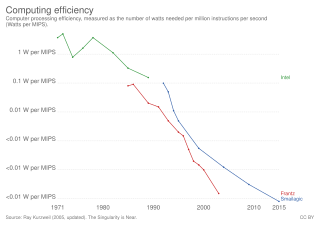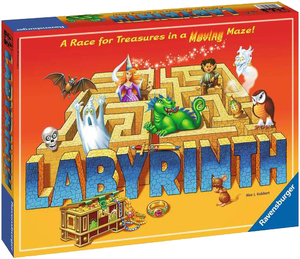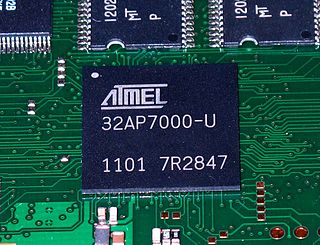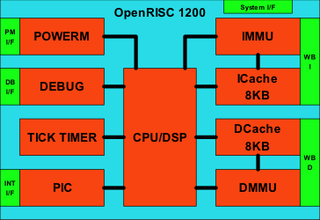Related Research Articles
Dhrystone is a synthetic computing benchmark program developed in 1984 by Reinhold P. Weicker intended to be representative of system (integer) programming. The Dhrystone grew to become representative of general processor (CPU) performance. The name "Dhrystone" is a pun on a different benchmark algorithm called Whetstone, which emphasizes floating point performance.
In computer performance testing, Khornerstone is a multipurpose benchmark from Workstation Labs used in various periodicals such as UNIX Review.

The Motorola 68060 ("sixty-eight-oh-sixty") is a 32-bit microprocessor from Motorola released in April 1994. It is the successor to the Motorola 68040 and is the highest performing member of the 68000 series. Two derivatives were produced, the 68LC060 and the 68EC060.

Instructions per second (IPS) is a measure of a computer's processor speed. For complex instruction set computers (CISCs), different instructions take different amounts of time, so the value measured depends on the instruction mix; even for comparing processors in the same family the IPS measurement can be problematic. Many reported IPS values have represented "peak" execution rates on artificial instruction sequences with few branches and no cache contention, whereas realistic workloads typically lead to significantly lower IPS values. Memory hierarchy also greatly affects processor performance, an issue barely considered in IPS calculations. Because of these problems, synthetic benchmarks such as Dhrystone are now generally used to estimate computer performance in commonly used applications, and raw IPS has fallen into disuse.
A solved game is a game whose outcome can be correctly predicted from any position, assuming that both players play perfectly. This concept is usually applied to abstract strategy games, and especially to games with full information and no element of chance; solving such a game may use combinatorial game theory or computer assistance.

Connect Four is a game in which the players choose a color and then take turns dropping colored tokens into a six-row, seven-column vertically suspended grid. The pieces fall straight down, occupying the lowest available space within the column. The objective of the game is to be the first to form a horizontal, vertical, or diagonal line of four of one's own tokens. It is therefore a type of m,n,k-game with restricted piece placement. Connect Four is a solved game. The first player can always win by playing the right moves.
The Whetstone benchmark is a synthetic benchmark for evaluating the performance of computers. It was first written in ALGOL 60 in 1972 at the Technical Support Unit of the Department of Trade and Industry in the United Kingdom. It was derived from statistics on program behaviour gathered on the KDF9 computer at NPL National Physical Laboratory, using a modified version of its Whetstone ALGOL 60 compiler. The workload on the machine was represented as a set of frequencies of execution of the 124 instructions of the Whetstone Code. The Whetstone Compiler was built at the Atomic Power Division of the English Electric Company in Whetstone, Leicestershire, England, hence its name. Dr. B.A. Wichman at NPL produced a set of 42 simple ALGOL 60 statements, which in a suitable combination matched the execution statistics.
KDF9 was an early British 48-bit computer designed and built by English Electric. The first machine came into service in 1964 and the last of 29 machines was decommissioned in 1980 at the National Physical Laboratory. The KDF9 was designed for, and used almost entirely in, the mathematical and scientific processing fields – in 1967, nine were in use in UK universities and technical colleges. The KDF8, developed in parallel, was aimed at commercial processing workloads.

Jumble is a word puzzle with a clue, a drawing illustrating the clue, and a set of words, each of which is “jumbled” by scrambling its letters. A solver reconstructs the words, and then arranges letters at marked positions in the words to spell the answer phrase to the clue. The clue, and sometimes the illustration, provide hints about the answer phrase, which frequently uses a homophone or pun.

In computing, a benchmark is the act of running a computer program, a set of programs, or other operations, in order to assess the relative performance of an object, normally by running a number of standard tests and trials against it.
SPEC INT is a computer benchmark specification for CPU integer processing power. It is maintained by the Standard Performance Evaluation Corporation (SPEC). SPEC INT is the integer performance testing component of the SPEC test suite. The first SPEC test suite, CPU92, was announced in 1992. It was followed by CPU95, CPU2000, and CPU2006. The latest standard is SPEC CPU 2017 and consists of SPEC speed and SPEC rate.

Labyrinth is a board game for two to four players, published by Ravensburger in 1986.

Venix is a discontinued version of the Unix operating system for low-end computers, developed by VenturCom, a "company that specialises in the skinniest implementations of Unix".

AVR32 is a 32-bit RISC microcontroller architecture produced by Atmel. The microcontroller architecture was designed by a handful of people educated at the Norwegian University of Science and Technology, including lead designer Øyvind Strøm and CPU architect Erik Renno in Atmel's Norwegian design center.
Smush is an American game show which aired on the USA Network on December 3, 2001, to June 21, 2002. Hosted by Ken Ober and Lisa Dergan, the show features contestants competing to form a portmanteau given clues.

The OpenRISC 1200 (OR1200) is an implementation of the open source OpenRISC 1000 RISC architecture.
CoreMark is a benchmark that measures the performance of central processing units (CPU) used in embedded systems. It was developed in 2009 by Shay Gal-On at EEMBC and is intended to become an industry standard, replacing the Dhrystone benchmark. The code is written in C and contains implementations of the following algorithms: list processing, matrix manipulation, state machine, and CRC. The code is under the Apache License 2.0 and is free of cost to use, but ownership is retained by the Consortium and publication of modified versions under the CoreMark name prohibited.
Solving chess consists of finding an optimal strategy for the game of chess; that is, one by which one of the players can always force a victory, or either can force a draw. It is also related to more generally solving chess-like games such as Capablanca chess and infinite chess. In a weaker sense, solving chess may refer to proving which one of the three possible outcomes is the result of two perfect players, without necessarily revealing the optimal strategy itself.
NBench, short for Native mode Benchmark and later known as BYTEmark, is a synthetic computing benchmark program developed in the mid-1990s by the now defunct BYTE magazine intended to measure a computer's CPU, FPU, and Memory System speed.
Sysinfo is a shareware program written completely in Assembler for the Motorola 68k equipped Amiga computers to benchmark system performance. Sysinfo shows which version of system software is present in ROM, which hardware is present, and which operating mode the hardware uses.
References
- ↑ "The Fhourstones Benchmark".
- ↑ Embedded Software: Second International Conference, EMSOFT 2002. Springer. 2003. p. 208.